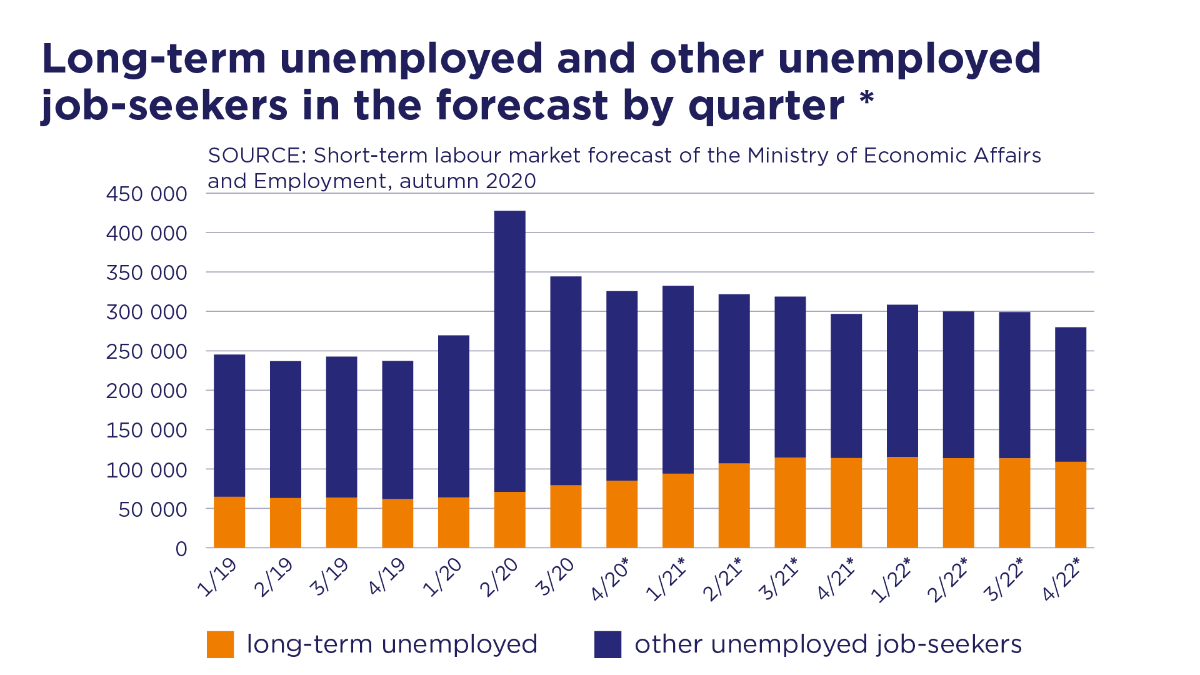The Government’s website is currently being upgraded. There may be temporary disruptions, including broken links and missing content.
Labour market forecast: Prolonged unemployment will shape the labour market as the pandemic continues

Uncertainty caused by the coronavirus crisis will continue in the economy and on the labour market The recovery of the labour market will begin in late 2021, though fairly moderately, There is also the risk that some of impacts on the labour market will continue for a long time.
The Ministry of Economic Affairs and Employment published a labour market forecast on 17 November 2020 that extends until 2022. The forecast reflects uncertainty about how the coronavirus pandemic and the economy will develop.
The number of employed people will decrease by tens of thousands and will reassume moderate growth in 2022
According to the labour market forecast, the employment rate will fall until 2021 and begin to rise again after that. Based on the forecast, the employment rate would be 71.6 per cent in 2022, i.e. clearly smaller than before the crisis.
The unemployment rate is projected to increase to 8.2 per cent in 2021 and fall to 7.8 percent in 2022. Its increase will be cushioned by growth in the number of people not part of the workforce and an increase in disguised unemployment and long-term unemployment.
In the baseline forecast, the number of employed people will decrease by approximately 76,000 during this and next year. Employment will begin to grow slowly in 2022, though there will still be approximately 60,000 less employed people than before the crisis.
The size of the labour force will decrease though the working age population will begin to return to the labour market recovering from the coronavirus crisis.
The labour market forecast also investigates the supply of labour force, i.e. the total number of employed and unemployed people. The working age population in Finland, i.e. people aged 15–74 years, is projected to adopt a sharp downturn in 2021, which will cause challenges to the Finnish labour market in the long term. Immigration sustains the number of prime working-age population aged 25–54 years and thus also the supply of labour.
The coronavirus crisis has reduced the supply of labour and the labour force participation rate of people aged 15–74 years and increased disguised unemployment. Prolonged lay-offs show as disguised unemployment, which reduces the supply of labour. However, it seems that to some extent the working-age population has begun to re-enter the labour force and the labour market, compared with the spring of 2020 and the onset of the coronavirus crisis.
The coronavirus crisis will continue to have a negative impact on the supply of labour and the labour force participation rate in 2021, as a result of which the rate is predicted to remain at 66.1 per cent. The labour force participation rate is again projected to increase to 66.4 per cent in 2022. As the labour market recovers, people in disguised unemployment gradually begin to re-enter the labour force.
The number of laid off people will level off, but long-term unemployment will increase sharply.
The number of unemployed job-seekers in employment service statistics, which also includes people laid off full time, will decrease moderately in the next few years. The number of laid off people is projected to remain high at least until summer 2021, though a lay-off wave of the kind encountered last spring is not expected.
However, long-term unemployment is projected to increase strongly in the newt few years. This is due to the longer duration of unemployment periods during the coronavirus pandemic as well as to the fact that some of the people who became unemployed last spring will face long-term unemployment next spring.
The average number of unemployed job-seekers is projected to be 342,000 in 2020, which is 101,000 more than in 2019. The forecast is 317,000 for 2021 and 297,000 for 2022. The number of long-term unemployed is projected to be 75,000 this year, which would be 11,000 more than in the previous year. It is predicted that the number of long-term unemployed people will be 107,000 in 2021 and as many as 113,000 in 2022. The number of unemployed people aged under 25 years is projected to be 44,000 in 2020, which is approximately 13,000 more than in the previous year. The forecast is 38,000 for 2021 and 35,000 for 2022.
The short-term labour market forecast of the Ministry of Economic Affairs and Employment is based on a statistical time-series analysis that makes use of economic indicators, labour market statistics and policy information, as well as the Ministry of Finance’s GDP forecast and the demographic forecasts of Statistics Finland. The forecast is published twice a year.
Further information:
Johanna Alatalo, Ministerial Adviser, Ministry of Economic Affairs and Employment, tel.+ 358 29 504 8084 (demand for labour, employment rate)
Juho Peltonen, Specialist, Ministry of Economic Affairs and Employment, tel.+358 50 471 1975 (supply of labour, disguised unemployment)
Erno Mähönen, Senior Specialist, Ministry of Economic Affairs and Employment, tel. +358 50 460 0066 (unemployed job-seekers, long-term unemployed, unemployed young people, laid-off people)